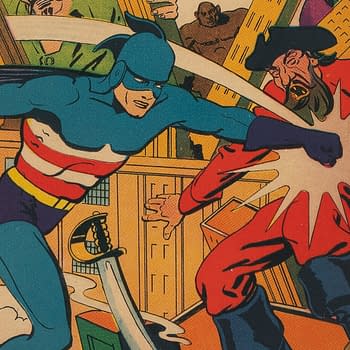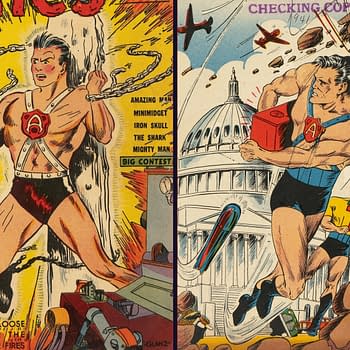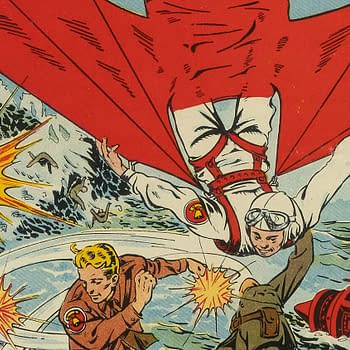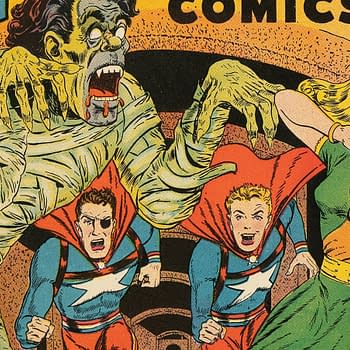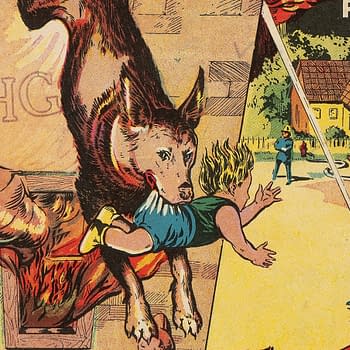Posted in: Comics, Heritage Sponsored, Vintage Paper | Tagged: dr. doom, electro, Fox Feature Syndicate, lou fine, victor fox
Dr. Doom and Electro in Science Comics #1, up for Auction
Characters such as Dr. Doom, Electro, and Marga the Panther Woman made their debuts in Fox Feature's Science Comics #1.
Article Summary
- Science Comics #1 introduced Dr. Doom, Electro, Marga the Panther Woman, and other Fox original heroes.
- Ray Cummings' visionary sci-fi work strongly influenced key stories and multiverse concepts in this issue.
- Electro was inspired by Westinghouse's Elektro robot and the 1939 New York World's Fair, reflecting tech optimism.
- Lou Fine's stunning cover, multiple first appearances, and notable rarity make Science Comics prized by collectors.
Victor Fox was not the kind of man to let a little legal scuffle slow him down. Despite fighting a then ongoing battle with DC Comics since the moment Wonder Comics #1 was released (Wonder Comics #1 has a copyright date of March 17, 1939, DC v Bruns was filed on March 16), Fox expanded his comics empire rapidly throughout the rest of that year. By the month that Science Comics #1 was released in January 1940, Fox had launched five ongoing comic book series. Fox's early releases are highly sought after by collectors due to a combination of their high-quality content and their relative rarity vs Marvel and DC Comics releases of the same era. With names like The Eagle, featuring a scientist with anti-gravity wings; Electro, master of electricity; Cosmic Carson, a space adventurer similar to Buck Rogers; Perisphere Payne, interplanetary explorer; Marga the Panther Woman, the product of a "mad physio-biologist"; Dr. Doom, an evil super-scientist and others, the characters of Science Comics were true to its title. The issue is a crucible of early science-fiction superhero concepts, directly inspired by the technological optimism of the 1939 New York World's Fair, yet it was also created in the looming shadow of global conflict. Science Comics #1 (Fox, 1940) is a stand-out example from Fox Feature Syndicate, and there's a Science Comics #1 (Fox, 1940) CGC FR/GD 1.5 Cream to off-white pages copy up for auction in the 2025 September 18 Golden Age Comics Century Showcase Auction II at Heritage Auctions.
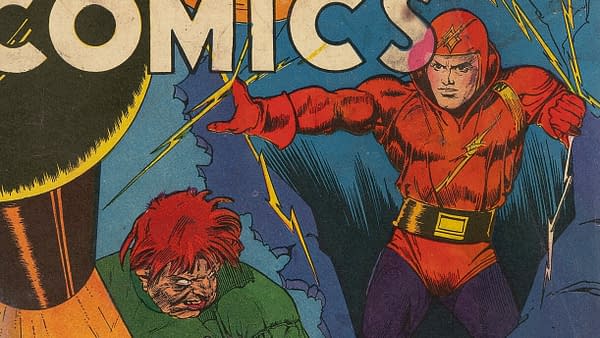
Like many other pulps and comics over the past century, the Dr. Doom story in Science Comics #1 appears to be influenced by the work of science fiction legend Ray Cummings. Cummings's work is the root influence of both the Marvel and DC Comics Multiverses. Cummings himself adapted his seminal Girl in the Golden Atom story for Marvel/Timely in a two-part story called Princess of the Atom in Captain America #25 & 26. One can make a pretty convincing argument that Princess of the Atom is Marvel's first Microverse story, which makes it the key to the Quantum Realm concepts that are so important to the MCU today. Cummings, who had worked for Thomas Edison as a technical writer, went on to become one of the most influential science fiction authors of the pulp era — and beyond. So influential, in fact, that other authors built on his concepts. Notably, Cummings also wrote a story about parallel worlds called Phantoms of Reality for Astounding Stories of Super-Science Volume 1 #1, cover-dated January 1930. A tale of similar-yet-different Earths separated by different "vibratory frequencies", is the clear inspiration for Gardner Fox's foundational story in Flash #123. It's easy to make the case that Cummings is the grandfather of both the Marvel and DC Multiverses.
Coincidentally, Marvel's more infamous Dr. Doom also provides us with the Marvel Silver Age link to the Quantum Realm with the introduction of what Doom called the "Micro-World" in Fantastic Four #16. The earlier Science Comics Dr. Doom called his Quantum Realm the "Molecular Kingdom", though with its microscopic life forms seeming to be relative giants compared to its shrunk-down human arrivals, the Science Comics Molecular Kingdom seems to have more in common with the MCU Quantum Realm than does the Silver Age Dr. Doom's Micro-World.
Science Comics is also a good example of another influence that has loomed large over pop culture in the subsequent decades. It's apparent that some of its characters were inspired by the New York World's Fair of 1939-1940. For example, Perisphere Payne is obviously named after one of the most famous symbols of the fair — the Trylon and Perisphere.
The character Electro from Science Comics #1 was also likely inspired by the New York World's Fair. Elektro, the robot created by Westinghouse Electric Corporation was one of the most famous exhibits at the fair. He was used by Westinghouse as a walking, talking advertisement of sorts, and a symbol of the modern wonders of electrical power. Science Comics #1's Electro was also symbolic of such wonders — so much so that his mastery of electricity reminds one of Magneto's absolute control of magnetism. Unfortunately for Victor Fox, his version was not the only comic book Electro inspired by the Westinghouse robot. Marvel's Electro debuted in Marvel Mystery Comics #4 — which beat Science Comics #1 to the newsstands by a mere two weeks. With Marvel's version more inspired by the robotic aspect of Westinghouse's Elektro rather than the notion of electrical wonders like Fox's version, it seems likely that Marvel and Victor Fox came to a simple agreement. Fox's version of Electro was renamed Dynamo with Science Comics #2.
Other historically important features in this series debut include The Eagle, a scientist who invents an anti-gravity fluid and a set of wings that allow him to fly and fight crime. The character proved popular enough to outlast the Science Comics title, eventually moving to Weird Comics, where he became the cover star, and briefly received his own series. Science Comics #1 also introduces Marga the Panther Woman, a nurse who is kidnapped by a "mad physio-biologist" and transformed by having panther blood fused into her system. The character is a fascinating blend of the popular "jungle girl" archetype (like Sheena) and the sci-fi/horror elements that were a Fox specialty.
A total of only 49 entries for Science Comics #1 appear on the CGC census currently, with only 37 of those as "Universal" unrestored. With a fantastic Lou Fine cover, a number of first appearances, and its historical importance, Science Comics is deserving of the attention it gets from vintage collectors. The debut issue Science Comics #1 (Fox, 1940) is key Fox, and there's a Science Comics #1 (Fox, 1940) CGC FR/GD 1.5 Cream to off-white pages copy up for auction in the 2025 September 18 Golden Age Comics Century Showcase Auction II at Heritage Auctions.






